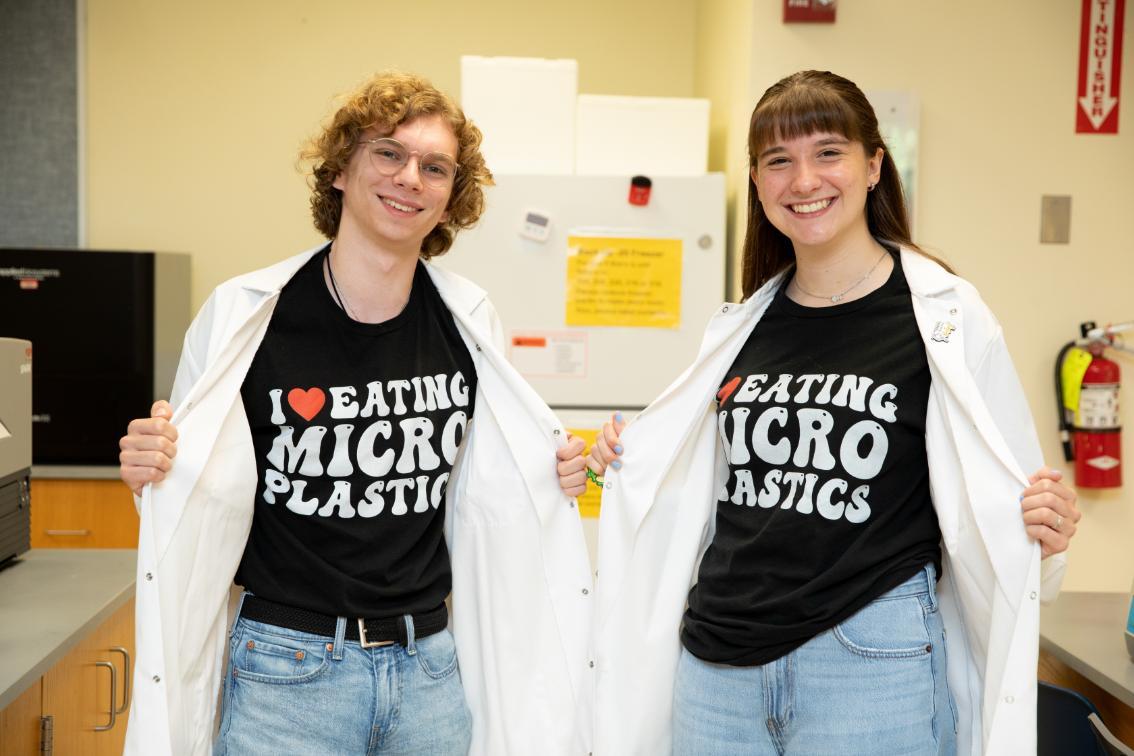

Emma Snead ’27 and Jay Geeslin ’27 step into the Chichester biology lab with flair, wearing black “I ❤️ EATING MICROPLASTICS” T-shirts as they share their summer research experience with high school students. The red heart on their shirts mirrors the enthusiasm they’ve found working with Dr. Amanda Starr, assistant professor of biology, on a molecular microbiology PRISM project that explores the impact of microplastics on a fungus deadly to frogs.
Batrachochytrium dendrobatidis, or Bd, is a fungus that attaches to the skin of frogs, causing frog skin sloughing. Eventually, the continuous sloughing leads to cardiac arrest, killing the frog. Microplastics are known to promote the growth of various pathogens by providing additional surface area, but little else is known about other impacts on bacteria or fungi in the presence of microplastics.
We’re looking at the effects of microplastics on the growth and virulence of this fungus, to see how the presence versus the absence of microplastics affects its growth.
Jay Geeslin ’27 Tweet This
“We’re looking at the effects of microplastics on the growth and virulence of this fungus, to see how the presence versus the absence of microplastics affects its growth,” said Geeslin, a biology major with minors in chemistry and creative writing.
PRISM is an eight-week summer research program that pairs a faculty member with one or two students to work collaboratively on a project in biology, chemistry, environmental science, mathematics, physics or psychology. This unique Longwood program allows students to experience working in a lab full-time and develop their research skills, a key asset in building their professional résumé.
Geeslin and Snead, a biology major with a pre-medical concentration, spent the first half of their summer learning how to do electron microscopy, culture the fungus, sterilize microplastics, pipetting and more.
We caught up with Snead and Geeslin to learn more about their summer research experience.
Tell us about your project.
Geeslin: Amphibians are really important in terms of biodiversity. They’re also a kind of indicator species, because of how sensitive they are to the environment and the ecosystem. Amphibians are subject to pollution, habitat loss, infectious diseases and everything else. There's a lot of things that are negatively impacting amphibians, but our particular interest is on a fungus called Batrachochytrium dendrobatidis, abbreviated as Bd. And on top of that, microplastics are also very environmentally abundant, and there have been observed negative impacts of microplastics on amphibians as well as the growth of various different pathogens. We’re looking at the effects of microplastics on the growth and virulence of Bd.
Reading the abstract, I was like, “Oh! Working with fungus? What does this have to do with RNA or DNA or stuff like that?” But it has a lot to do with that, and that’s something I love to do.
Emma Snead ’27 Tweet This
How has your experience been so far?
Snead: I am interested in a lot of different fields. I want to look at forensics, but I also want to keep my mind open to possible research and something in the genetics field. Honestly, I didn't know how I would like this project, but it turned out that I love it! Reading the abstract, I was like, “Oh! Working with fungus? What does this have to do with RNA or DNA or stuff like that?” But it has a lot to do with that, and that’s something I love to do.
Geeslin: There’s a lot of aspects of biology that I like and a lot of things I find interesting. But I like getting to dive into the genetics side. It’s been a lot of fun. I wasn't sure exactly what to expect going into it, but I haven’t been disappointed in any way. I've really enjoyed it.
What does a typical day in the lab look like?
Snead: We normally get here in the morning and do some basic maintaining of cultures and inoculating plates until they’re warm again.
Geeslin: There’s some recurring things we have to do, like sterilize all the micropipette tips that we use in glassware. And we make the medium to grow the fungus in, and then we sterilize it. We have to maintain the culture because the fungus has a seven day life cycle period, and then it uses up its nutrients. Tomorrow we’re doing another RNA extraction, where we're going to take “the goods” and grind them down to pull out RNA. Then we will check to make sure it's actually RNA and not DNA, and then later on we can analyze that for data. So it's a lot of different things, plus a lot of pipetting and cell counting.
What has been your favorite part of PRISM so far?
Snead: It’s really hard to do focused research during the semester when you have so much class work on top of your research. It’s nice to focus on just one thing and enjoy what you’re doing and the people that you’re around. We’ve also gotten better connected with all the professors and learned new skills in the lab, such as how to use an inverted microscope, how to use cameras with the microscopes, and how to use softwares and new machines.
Geeslin: The community is also really nice. I don’t feel isolated because the people I’m around are nice and very supportive. So that's cool.
Being able to do research, especially at an undergraduate level, isn’t something that people at larger schools really have the opportunity to do. I would 1,000 percent recommend taking advantage of this opportunity.
Jay Geeslin ’27 Tweet This
Would you recommend PRISM to other students?
Snead: Yes!
Geeslin: Absolutely. Being able to do research, especially at an undergraduate level, isn’t something that people at larger schools really have the opportunity to do. I would 1,000 percent recommend taking advantage of this opportunity.
